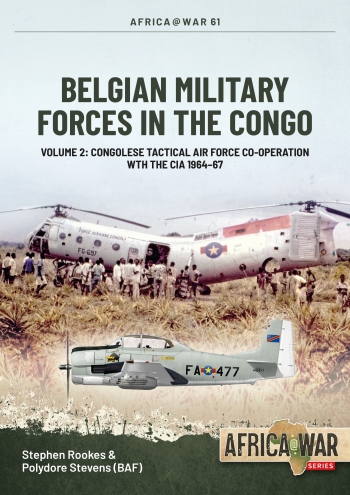
- aviationmegastore.com
- Ship to United States
Quick Search
Aviation Shop
categoriesPublic holidays
Amended or confirmed operating hours of the Luchtvaart Hobby Shop in Aalsmeerderbrug on the following dates:
Aviation Megastore website is available without limitations. Orders are processed during shop operating hours.
| Tu | 24 Dec. | Open 10-15 hrs |
| We | 25 Dec. | Closed: Christmas |
| Th | 26 Dec. | Closed: Christmas |
| Tu | 31 Dec. | Open 10-15 hrs |
| We | 1 Jan. | Closed: New Year's Day |
Belgian Military Forces in the Congo Volume 2: Congolese Tactical Air Force Co-operation with the CIA 1964-1967
Product code 9781804510124
€ 24.72
Series Africa @ War 61
Publisher/Brand Helion & Company
Author Stephen Rookes
No. Pages 94
Version Soft cover
Language English
Category Books on aviation
Subcategory World Wars » War in Africa
Availability In stock
This product was added to our database on Monday 20 february 2023.
Your reliable Aviation Book Source since 1989
Also in this series:
Product description
Although Belgium officially withdrew its military forces from the Democratic Republic of the Congo (DRC) in July 1960, unofficially the former colonial ruler of this central African country maintained a political, economic, and military presence throughout the period known as the Congo Crisis, 1960–1967. Belgium's military presence is seen mainly through its relations with the secessionist state of Katanga from 1960 to 1963 and through what was termed "technical assistance".
By April 1964, the DRC was, once again, threatened by internal conflict that threatened its national integrity. The Armée Nationale Congolaise (ANC) being ill-equipped to deal with two separate rebellions that broke out in the Kwilu and Kivu provinces that year, had, nonetheless, the support of a CIA-sponsored air force composed principally of anti-Castro Cuban exiles. This air force receiving reinforcements in the shape of Harvard T-28s at the beginning of 1964, with other aircraft delivered by the CIA including Douglas C-47s, and Vertol-Piasecki H21s, the US government sought reassurances that these aircraft would be correctly maintained. After discussions were held between the US and Belgium, it was agreed that Belgium would provide further technical assistance in the DRC.
Set up at the end of May 1964, the Force Aérienne Tactique Congolaise (FATAC), or the Belgian Tactical Air Force, would remain in the Congo until 1967 where its role was to assist the different armed forces of the DRC to put down the so-called 'Simba Rebellion'. These forces, including the aforementioned CIA air force, also included a mercenary army employed to re-establish order to the Congo.
In this second volume dealing with Belgian military forces in the Congo, the history of the FATAC is told using eye-witness accounts from veterans of the unit plus an array of documents relating to the period in question. This volume is a valuable addition to anyone wishing to supplement their knowledge of the Congo Crisis.
Shopping cart
Your shopping cart is empty.
Login
- aviationshopsupplies.com
- aviationmegatrade.com
© 1989–2024 Luchtvaart Hobby Shop B.V.









